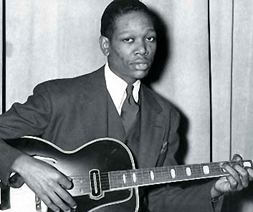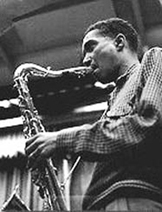Charlie Christian and Wardell Gray: “The Real Secret of the Game Is To Make Life Swing”
By Stuart Mitchner
“Negro American style” is defined by novelist Ralph Ellison as “the sudden turns, shocks, and swift changes of pace (all jazz-shaped) that serve to remind us that the world is ever unexplored and that while a complete mastery of life is mere illusion, the real secret of the game is to make life swing.”
For anyone looking to make life swing in this hot, heavy summer I recommend the elixir of Christian and Gray. While the joy and energy may be coming from long ago and far away, the message delivered by the electric guitar of Charlie Christian and the tenor sax of Wardell Gray is that the music of life plays on in spite of deranged demagogues, poverty and misery, mass shootings, and terrorist attacks.
Achieving renown in the early and mid-1940s, each as a featured soloist with Benny Goodman, Charlie and Wardell are so alike in the force and clarity of their playing they might be two poets writing the same poem, composing on the spot, making free translations of one another’s verses, the guitarist’s line moving along as if in the same metre as the saxophonist’s, brave, joyous, unstoppable, irresistible.
Deep Deuce
The story begins a hundred years ago in Oklahoma City around the time municipal officials passed an ordinance confining black families to a neighborhood along 2nd Street that came to be known as Deep Deuce and was home to both Christian (1916-1942) and Gray (1921-1955). As the dates indicate, 2016 marks the guitarist’s 100th birthday and the tenor’s 95th. Christian died at 25 from TB, Gray at 34 after a drug-related misadventure.
In his collection of jazz writings, Living With Music, another Oklahoma City native, Ralph Ellison (1913-1994), recalls how Lester Young’s arrival in Deep Deuce left “absolutely no reed player and few young players of any instrument unstirred by the wild, excitingly original flights of his imagination.” Though Gray was only 8 at the time and Christian 13, both were definitively influenced by Young. A decade later Gray had memorized his solos and Christian was playing with him in sessions with the Goodman Sextet.
Although Gray moved to Detroit with his family when he was nine, he’d have been exposed to the heady musical environment of Deep Deuce, in particular the Christian family, which included a blind father who played guitar and sang and two brothers who played violin and guitar while Charlie was spending his time in the manual-training department of Douglass School “constructing guitars from cigar boxes,” instruments on which he was, in Ellison’s words, “dazzlingly adept.” Charlie also accompanied his father and brothers strolling through the white middleclass sections of Oklahoma City, earning money playing serenades on request.
By the 1920s, Deep Deuce had become a self-sufficient black community with a thriving entertainment industry, including the Aldridge Theatre, Slaughter’s Hall, and Ruby’s Dance Hall and Grill. Ellison remembers singer Jimmy Rushing as “the natural herald” of the neighborhood’s “blues-romance, his song the singing essence of its joy.” Although they were “pushed off to what seemed to be the least desirable side of the city … there was an optimism within the Negro community and a sense of possibility which, despite our awareness of limitation (dramatized so brutally in the Tulsa riot of 1921), transcended all of this, and it was this rock-bottom sense of reality, coupled with our sense of the possibility of rising above it, which sounded in Rushing’s voice.”
“Limitation” seems an odd choice of words for what happened in Tulsa when 300 people died and an entire black community was burned to the ground, or for the white-mandated restriction to the “least desirable area” of Oklahoma City where, Ellison suggests, the unsanitary conditions sealed Charlie Christian’s fate: “the wooden tenement” he grew up in being “full of poverty, crime and sickness …” — it was “doubtless here that he developed the tuberculosis from which he died.”
A lifetime dealing with the effects of “limitation” also infected and brought down Wardell Gray. With all his gifts, his intelligence, his humanity, his interest in art and music and literature and the world beyond jazz, his love for his family and his wife, with everything he had going for him, it wasn’t enough to save him from death in the desert outside Jim Crow Las Vegas, his body dumped in a ditch.
The Man I Love
One of the first long-playing records I ever bought was Charlie Christian Jazz Immortal, which contained two numbers, “Swing to Bop” and “Stompin’ at the Savoy,” each one a side-long cut from a jam session in May 1941 at Minton’s Playhouse recorded by Jerry Newman, a Horace Mann classmate and pal of Jack Kerouac’s. This being in the days before rock and roll, I had no compelling interest in the electric guitar, but Christian’s playing was addictive. I lived with it, moved with it, did homework to it.
While I’d known Wardell Gray from his playing on Norman Granz’s Jam Session albums and the famous tenor duels with Dexter Gordon, it wasn’t until the late 1990s that I really began to appreciate him, the revelation coming with his unforgettable reimagining of Gershwin’s “The Man I Love,” a fitting title because that’s when the romance began. I’d say “one-way romance,” except that the more I hear of his music, the more he enriches my life. The closest I came to the man was in June 2003 when his wife Dorothy called me long-distance from Los Angeles after reading my article about him in the Village Voice. “You brought him back to me,” she said. I bring him back by playing his music, which I make a point of doing every February 13, the day he was born, and every May 25, the night he died.
“Distancing” and “Limitation”
Ralph Ellison was 38 when Invisible Man astonished the literary world, winning the National Book Award on its way to becoming a 20th-century classic. Whether or not the daunting magnitude of his success was to blame, he struggled for the next 42 years to produce a second novel, publishing only excerpts while he was alive. There was a posthumous book-length condensation, Juneteenth, in 1999, and in 2010, 16 years after his death, the 1,100 unfinished manuscript, Three Days Before the Shooting. His biographer Arnold Rampersad thinks that Ellison’s “inability to create an art that held a clean mirror up to ‘Negro’ [Ellison’s preferred term] life as blacks actually led it, especially at or near his own social level, was disabling him as a writer. As a novelist, he had lost his way. And he had done so in proportion to his distancing himself from his fellow blacks.”
While I don’t mean to be parsing the language of the author of one of the most powerful novels I ever read, the word “distancing” reminds me of Ellison’s use of that bloodless, ineffectual term “limitation” to convey the bondage of segregation. Of course Invisible Man is itself a massive indictment of the American madness of racism, as is his savage story, “A Party Down at the Square,” which is told from the point of view of a callous, clueless white youth witnessing a lynching.
Gray and Obama
Wardell Gray was tall, thin, handsome, and light-skinned, like Barack Obama, whose presidency has exposed the same American madness that is even now energizing the presidential campaign of the man who only a few years ago was beating the “birther” drum. The hyperbole of “high-tech lynching,” the term used by Supreme Court Justice nominee Clarence Thomas during the Senate hearings, is more applicable to what’s been going on ever since Obama took office.
The Lynching That Never Happened
It’s likely that Gray knew about the Memorial Day 1921 race war in Tulsa, if only because he’d been born a mere three months earlier in Oklahoma City. It’s also possible that he discussed the event with his fellow sideman, trumpet player Howard McGhee, on the historic “Relaxin at Camarillo” session with Charlie Parker in 1947. Born in Tulsa in 1918, McGhee was presumably living in Greenwood at the time, the Negro neighborhood savaged by an army of whites committing a massacre that amounted to spontaneous local genocide. The appalling details can be found online. The attack, carried out on the ground and by air, destroyed more than 35 blocks of the district. Along with the death toll of 300, an estimated 10,000 people were made homeless, and 1,256 homes and 191 businesses destroyed by fire, as well as the community’s churches, junior high school, and hospitals.
From what we know, all that death and destruction happened because a 19-year-old black named Dick Rowland accidentally jostled a 17-year-old white female elevator operator named Sarah Page in a building in downtown Tulsa. She screamed, someone heard her, saw the black man running, and Rowland was arrested the next day. A local newspaper played up the incident with a headline, “To Lynch Negro Tonight,” that attracted a white mob and a group of armed blacks who came to defend Rowland. Outnumbered and outgunned, the blacks retreated to Greenwood, and so it began. The case against Rowland was dismissed in September 1921 when the girl sent a letter to the county attorney saying she did not wish to press charges. Rowland left town, headed, it was said, to Kansas City. He called himself Diamond Dick. The rest of his history is unknown, though not necessarily for all time, given the ingenious ways of the internet. Is there a moral to the story of Diamond Dick, whose almost-lynching set off a race war? Or is it like looking for a moral in one of Wardell Gray’s long, swinging solos or in one of Charlie Christian’s? Songs and novels have been and will be written, but the idea of the man walking away from it all, a lone figure with a survivor’s swagger, makes me think of Ellison’s words about Negro American style, where “the world is ever unexplored” and “the real secret of the game is to make life swing.” Or Jack Kerouac’s line from Visions of Cody about a kid “who stood slumped with his horn and blew like Wardell … and we all stumbled out into raggedy American realities from the dream of jazz.”



